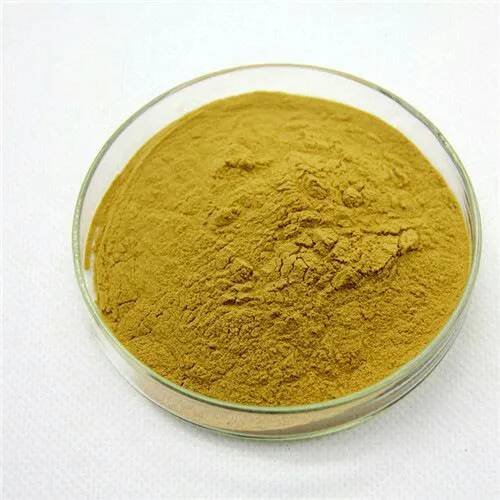- 0086-571-85302990
- sales@greenskybio.com
The process of extracting echinacea active ingredients from echinacea extract.
2024-11-28

1. Introduction to Echinacea
Echinacea is a well - known herbaceous plant that has been used for centuries in traditional medicine. It is native to North America and is recognized for its potential health - promoting properties. Echinacea contains a variety of bioactive substances, which are the focus of extraction processes. These substances are believed to have immunomodulatory, anti - inflammatory, and antioxidant effects among others.

2. Collection and Initial Processing of Echinacea Plants
2.1 Collection
The first step in obtaining the raw Echinacea Extract is the proper collection of Echinacea plants. This process requires careful consideration of several factors.- The plants should be collected at the appropriate time of the year. For most Echinacea species, the best time for collection is during the flowering stage when the concentration of active components is relatively high.
- Only healthy plants should be selected for collection. Diseased or damaged plants may have altered chemical compositions and may not yield high - quality extracts.
- Collection should be done in a sustainable manner to ensure the long - term availability of Echinacea in its natural habitat. This may involve following regulations regarding the amount of plants that can be harvested from a particular area.
2.2 Initial Processing
Once the plants are collected, initial processing is carried out.- The plants are typically cleaned to remove dirt, debris, and other contaminants. This can be done by gently washing the plants with clean water.
- After cleaning, the plants may be dried. Drying helps to preserve the plants and also concentrates the active components. There are different drying methods available, such as air drying, oven drying, or freeze - drying. Each method has its own advantages and disadvantages. For example, air drying is a natural and cost - effective method, but it may take longer compared to oven drying. Freeze - drying, on the other hand, is a more advanced method that can better preserve the chemical structure of the active components but is also more expensive.

3. Solvent Extraction
3.1 Choice of Solvent
Solvent extraction is a commonly used technique in the extraction of active components from Echinacea Extract. Ethanol is one of the most frequently used solvents for several reasons.- Ethanol has a relatively good selectivity for the active components in Echinacea. It can dissolve a wide range of bioactive substances, such as phenolic compounds, alkylamides, and polysaccharides, while leaving behind some of the unwanted substances.
- It is a relatively safe solvent compared to some other organic solvents. Ethanol is also miscible with water, which allows for the extraction of both water - soluble and lipid - soluble components depending on the ethanol - water ratio used.
- However, other solvents such as methanol, acetone, and ethyl acetate can also be considered depending on the specific active components to be extracted. For example, if the focus is on extracting more lipophilic components, ethyl acetate may be a better choice.
3.2 Extraction Process
The solvent extraction process involves several steps.- The dried and ground Echinacea plant material is placed in a suitable extraction vessel. The ratio of plant material to solvent is an important parameter. A common ratio is around 1:5 to 1:10 (plant material:solvent by weight).
- The solvent is then added to the vessel, and the mixture is stirred or agitated. This helps to increase the contact between the solvent and the plant material, facilitating the dissolution of the active components. Stirring can be done mechanically using a stirrer or magnetically in a closed vessel.
- The extraction is usually carried out at a specific temperature. For ethanol extraction, a temperature range of 20 - 50°C is often used. Higher temperatures can increase the extraction rate but may also lead to the degradation of some heat - sensitive components. The extraction time also varies depending on factors such as the type of plant material, the solvent used, and the desired extraction efficiency. It can range from a few hours to several days.
- After the extraction period, the mixture is filtered to separate the liquid extract (containing the dissolved active components) from the solid plant residue. Filtration can be done using filter paper, a Buchner funnel, or other filtration devices depending on the scale of the extraction.

4. Purification of the Extract
4.1 Filtration
Filtration is an important initial step in the purification process. After the solvent extraction, the extract may still contain some small particles of plant debris or insoluble substances.- Coarse filtration can be done first to remove the larger particles. This can be achieved using a simple filter paper or a sieve. For example, a Whatman filter paper with a suitable pore size can be used for this purpose.
- Fine - filtration is then carried out to further remove smaller particles. Membrane filtration or ultra - filtration techniques can be employed for this. Ultra - filtration membranes with different molecular weight cut - offs can be used to separate substances based on their molecular size. This helps in obtaining a cleaner extract and also prepares the extract for further purification steps.
4.2 Chromatography
Chromatography is a powerful technique for the precise separation and purification of the desired active components from the Echinacea Extract.- High - Performance Liquid Chromatography (HPLC) is widely used in the purification of Echinacea active components. In HPLC, the extract is pumped through a column filled with a stationary phase (such as silica or a bonded - phase material). The mobile phase, which is a solvent or a mixture of solvents, carries the components of the extract through the column. Different components interact differently with the stationary and mobile phases, resulting in their separation. The separated components can be detected and collected at the outlet of the column. HPLC can achieve very high resolution and is suitable for the purification of small amounts of high - value active components.
- Another type of chromatography is Column Chromatography. It is a more traditional but still widely used method. In column chromatography, a larger column is filled with a suitable adsorbent material (such as alumina or silica gel). The extract is loaded onto the top of the column, and then a solvent (eluent) is passed through the column. The components of the extract are separated based on their differential adsorption and desorption properties with respect to the adsorbent and the eluent. Column chromatography is often used for preparative - scale purification, especially when larger amounts of the extract need to be processed.

5. Quality Control and Assurance
Throughout the process of extracting Echinacea active ingredients from Echinacea extract, quality control and assurance are crucial.
- Chemical Analysis: Chemical analysis techniques are used to determine the composition of the extract and the purity of the active components. Techniques such as Gas Chromatography - Mass Spectrometry (GC - MS) and Liquid Chromatography - Mass Spectrometry (LC - MS) can be used to identify and quantify the various bioactive substances in the extract. These techniques can provide detailed information about the chemical structure and concentration of the components, ensuring that the desired active components are present in the required amounts.
- Biological Activity Testing: In addition to chemical analysis, the biological activity of the extracted active components is also tested. This is important as the ultimate goal is to obtain components with the desired pharmacological effects. For example, immunomodulatory assays can be carried out to determine if the Echinacea active components can enhance or modulate the immune system. Anti - inflammatory assays can also be performed to evaluate the anti - inflammatory potential of the components.
- Process Monitoring: During the extraction and purification processes, various parameters need to be monitored. These include temperature, pH, extraction time, and solvent ratios. Strict control of these parameters ensures the reproducibility and quality of the final product. For example, if the extraction temperature is not properly controlled, it may lead to the degradation of some active components, resulting in a lower - quality extract.
6. Conclusion
The process of extracting Echinacea active ingredients from Echinacea extract is a multi - step and complex procedure that requires scientific knowledge and strict control of various parameters. From the collection and initial processing of Echinacea plants to solvent extraction and purification steps, each stage plays a crucial role in obtaining high - quality active components. Quality control and assurance throughout the process are essential to ensure the effectiveness and safety of the final products. With the increasing interest in natural products and their potential health benefits, the extraction of Echinacea active components will continue to be an important area of research and development.
FAQ:
What are the main active ingredients in Echinacea?
Echinacea contains various bioactive substances, such as alkamides, caffeic acid derivatives, polysaccharides, and glycoproteins, which are considered to be the main active ingredients contributing to its potential health benefits.
Why is solvent extraction used in the process?
Solvent extraction is used because different solvents, like ethanol, can selectively dissolve the active components in Echinacea extract. This helps in separating the desired active substances from other components in the raw extract.
What is the role of chromatography in the purification step?
Chromatography is used in the purification step to precisely separate and purify the desired active components. It can separate substances based on their different physical and chemical properties, such as molecular size, polarity, etc., ensuring the purity of the final active components.
How important is the initial processing of Echinacea plants?
The initial processing of Echinacea plants is very important. Proper collection and initial processing ensure the quality of the raw Echinacea extract. It can affect the content and quality of the active ingredients that can be extracted later.
What parameters need to be strictly controlled during the extraction process?
During the extraction process, parameters such as temperature, solvent concentration, extraction time, and pH need to be strictly controlled. These parameters can significantly influence the extraction efficiency and the quality of the final active components.
Related literature
- Isolation and Characterization of Bioactive Compounds from Echinacea"
- "The Extraction and Purification of Echinacea Active Ingredients: A Review"
- "Optimization of the Extraction Process of Echinacea Active Components"
- ▶ Hesperidin
- ▶ citrus bioflavonoids
- ▶ plant extract
- ▶ lycopene
- ▶ Diosmin
- ▶ Grape seed extract
- ▶ Sea buckthorn Juice Powder
- ▶ Beetroot powder
- ▶ Hops Extract
- ▶ Artichoke Extract
- ▶ Reishi mushroom extract
- ▶ Astaxanthin
- ▶ Green Tea Extract
- ▶ Curcumin Extract
- ▶ Horse Chestnut Extract
- ▶ Other Problems
- ▶ Boswellia Serrata Extract
- ▶ Resveratrol Extract
- ▶ Marigold Extract
- ▶ Grape Leaf Extract
- ▶ blog3
- ▶ blog4
-
Standard - process Nutmeg extract.
2024-11-28
-
The best honeysuckle pollen on the market.
2024-11-28
-
The Best Rosemary Extract in 2024.
2024-11-28
-
The best - quality feverfew extract.
2024-11-28
-
The best organic aged garlic extract.
2024-11-28
-
Licorice Root Extract Powder
2024-11-28
-
White Peony Extract
2024-11-28
-
Black Rice Extract
2024-11-28
-
Kelp Extract Powder
2024-11-28
-
Black Garlic Extract
2024-11-28
-
American Ginseng Root Extract
2024-11-28
-
Longan Extract
2024-11-28
-
Alfalfa Meal
2024-11-28
-
Diosmin
2024-11-28
-
Phellodendron Extract
2024-11-28





















